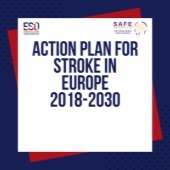 The action plan provides a clear road map and suggests recommendations and targets for 2030 as an aide to governments. It has the aim of improving stroke care and reverse the expected trend of a 34% increase in strokes by 2035, as well as a 45% increase in the number of stroke deaths and 25% increase in the number of stroke survivors living with the effects of stroke.
The action plan provides a clear road map and suggests recommendations and targets for 2030 as an aide to governments. It has the aim of improving stroke care and reverse the expected trend of a 34% increase in strokes by 2035, as well as a 45% increase in the number of stroke deaths and 25% increase in the number of stroke survivors living with the effects of stroke.
The action plan was presented for the first time at the European Stroke Organisation Conference (ESOC; 16–18 May 2018, Gothenberg, Sweden). Organised by ESO with cooperation from SAFE (Stroke Alliance for Europe) with input from the World Health Organisation’s Regional Office for Europe. Building on previous Helsingborg Declarations (1995 and 2006), this update reviews the current situation in Europe and focuses the targets on areas with room for improvement as highlighted in the ESO/SAFE Burden of Stroke report. The document contains two news areas within the action plan, primary prevention and life after stroke, as well as the existing five (stroke organisation services, acute stroke management, secondary prevention, rehabilitation, evaluation of quality and outcomes).
The Action Plan is a collaborative initiative to define the priorities for stroke care and research across Europe over the next decade, and provide guidance for European and national plans encompassing the chain of care from primary prevention to rehabilitation and life after stroke.
Over 100 people were involved in the formulations of the action plan and a consensus conference was held in March 2018 to finalise the strategy. There are four overarching targets for 2030.
The first is to reduce the absolute number of strokes in Europe by 10%. Commenting on this target Bo Norrving, chair of the Stroke Action Plan for Europe steering committee (Lund University, Lund, Sweden) said, “What is effecting the absolute number of strokes is the risk of having a stroke and this is related to the population growth and to the ageing of the population. We know that it is possible to reduce the risk of stroke. In Sweden in the last eight years we have seen a 40% reduction in the number of strokes and from this we know that this can be achieved everywhere.”
The second is to treat 90% or more of all patients with stroke in Europe in a stroke unit as the first level of care. Norrving said, “This is a basic requirement. Patients need to come to the right department from the beginning so they get the right care. We know that presently in Europe less than half of all patients are treated in stroke units, despite having the knowledge that everyone should get this type of care.”
The third target of the action plan is to have national plans for stoke encompassing the entire chain of care from primary prevention through to life after stroke. Norrving explained, “We have seen the importance of having a national plan for stroke. We have seen in the UK, for instance, that it made a big change when there was government support and a national plan. It really develops the stroke services.”
The fourth target is to fully implement national strategies for multi-sectorial public health interventions promoting and facilitating a health life-style, and reducing environmental (including air pollution), socioeconomical and educational risk factors that increase the risk of stroke.
“Stroke has an enormous potential to have a better outcome. We can limit the disease; we need to reduce the number of stroke in the population otherwise the healthcare system for stroke will simply flood. The next stop [for the action plan] is to join hands with politicians and governments to see that this will be accomplished,” concluded Norrving.













